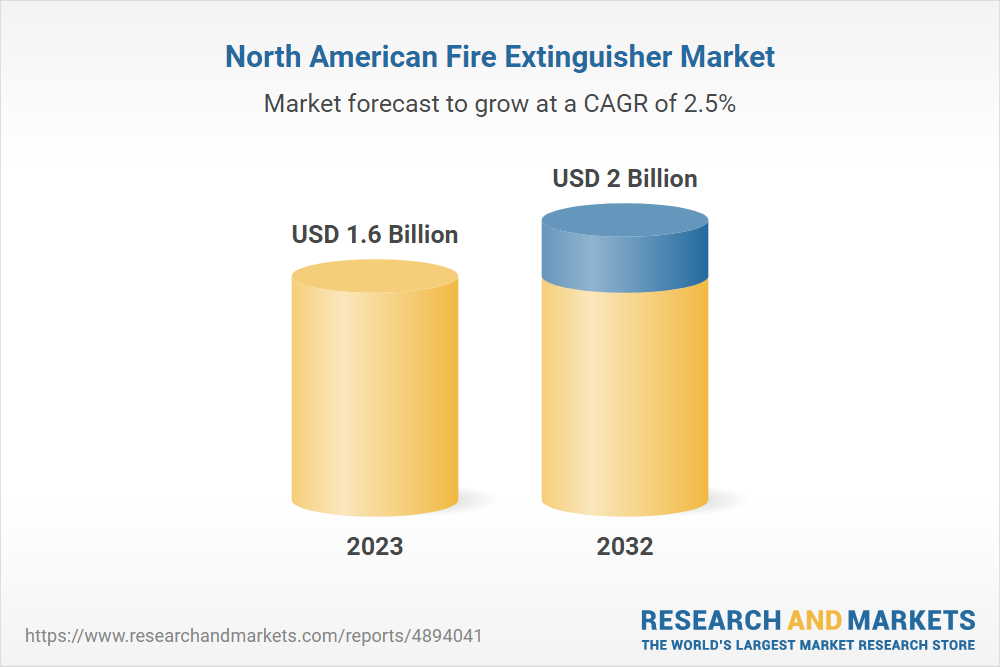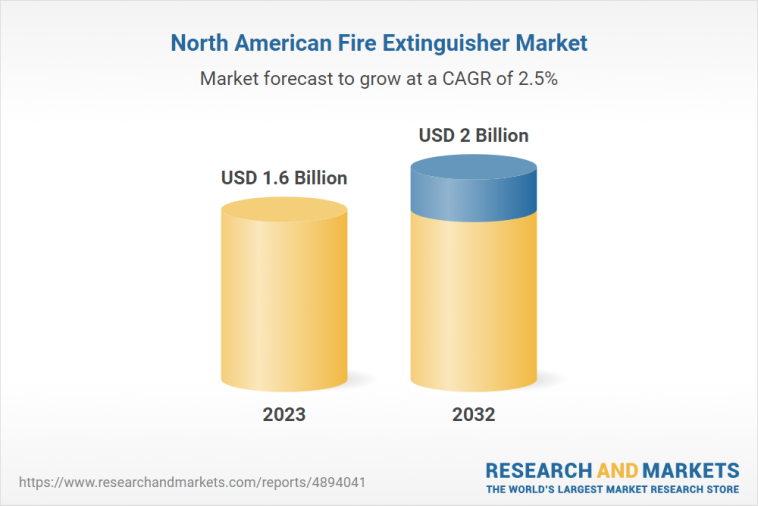
North America Fire Extinguisher Market: An Opinion on Steady Growth and Shifting Dynamics
The fire safety equipment market in North America has seen steady growth over the years, with fire extinguishers at the core of public safety strategies. In this editorial, we take a closer look at the sector, weighing its opportunities against several challenging bits. Our discussion touches on everything from regulatory changes and technological advances to the cost of maintenance and the market’s hidden complexities.
The market is expected to rise from approximately USD 1.74 billion in 2024 to an estimated USD 2.24 billion in 2033, growing at a compound annual growth rate of 2.84%. While these figures indicate a positive trend, they also shine a light on the off-putting and nerve-racking twists and turns that stakeholders must manage to keep up with evolving fire safety norms.
Understanding the Landscape: Product Variations and Market Segmentation
Fire extinguishers come in a host of types—portable, wheeled, and knapsack. Their designs range from simple manual equipment to sophisticated systems outfitted with sensors for predictive maintenance. These products are categorized by the extinguishing agents they deploy, including dry chemical powders, carbon dioxide, foam, and clean agents. Each agent is uniquely formulated to handle specific classes of fires: Class A, B, C, D, and K.
It is critical to note that building codes and standards in both the United States and Canada mandate routine inspections and regular maintenance. This requirement is one of the main drivers of market growth, as it pushes both commercial and residential property owners to invest in fire safety equipment. However, when it comes to managing the little details of maintenance costs and compliance, many businesses face tricky parts that can seem overwhelming.
Market Segmentation and Subcategories
The North America fire extinguisher market can be segmented into various categories that provide insights into consumer behaviors and industry demands. These include, but are not limited to:
- By Product: Portable, Wheeled, Knapsack
- By Extinguishing Agent: Dry Chemicals, Carbon Dioxide (CO₂), Foam, Others
- By Fire Type: Class A, B, C, Others
- By Application: Industrial, Public Areas, Commercial, Households
- By Geography: U.S., Canada, Rest of North America
Each segment has its own set of hidden complexities that merit a closer look. For instance, portable extinguishers dominate the revenue share due to regulatory mandates, while wheeled extinguishers are growing fast, thanks to their expanded use in larger industrial zones and transportation hubs.
Regulatory Frameworks and Their Impact on Market Dynamics
Government regulations play a super important role in shaping the market. Fire safety codes mandated by organizations such as the National Fire Protection Association (NFPA) in the United States and the Canadian Standards Association (CSA) have forced property owners, businesses, and even governments to take fire protection very seriously. While these codes are designed to protect lives and property, they also bring along a series of tricky regulatory twists and turns.
Key regulatory initiatives include:
- Mandatory inspections and regular maintenance routines.
- Specific codes for commercial establishments, industrial settings, and residential properties.
- Enhanced safety guidelines for transportation, including aviation and rail transport.
- Environmental compliance requirements that push the industry towards more eco-friendly fire suppression agents.
These rules are not without their challenging bits. For example, in Canada, periodic fire code reviews and amendments—such as those recently seen in Ontario—have increased the pressure on business owners to invest in maintenance and timely replacements. Although these measures are essential for public safety, they add layers of bureaucracy that many small businesses find intimidating.
Technological Advancements: The Rise of Smart Fire Extinguishers
Technological progress has brought some exciting innovations to the fire extinguisher market. Among the most notable is the integration of Internet of Things (IoT) technology in fire safety equipment. Smart fire extinguishers now come equipped with pressure sensors and remote monitoring capabilities that alert maintenance teams in real time when issues arise. This means that instead of waiting for periodic checks, facility managers can get live updates on equipment condition.
This new wave of innovation helps address a number of tangled issues:
- Real-time monitoring: Sensor-based systems provide instantaneous feedback about pressure drops and potential tampering, reducing the risk of non-compliance.
- Predictive maintenance: Technology makes it easier to forecast when servicing will be needed, thus minimizing downtime and costly service delays.
- Integration with building management systems: This means that large facilities can monitor multiple units across different sites, simplifying the maintenance process.
While these advancements provide significant benefits, they also contribute to the overall market price, making smart devices a more expensive proposition for some smaller operators. Nevertheless, the benefits of increased safety and efficient oversight frequently outweigh the additional costs, especially in high-risk environments like data centers, hospitals, and airports.
Cost and Maintenance: Tackling the Expense of Upkeep
One of the nerve-racking aspects of the fire extinguisher market is the long-term cost associated with regular maintenance, refilling, and compliance checks. Although the initial purchase of fire extinguishers may seem moderate, the ongoing expenses paint a more challenging picture. Many small businesses and residential users find these recurring costs particularly intimidating.
Some of the ongoing financial challenges in the market include:
- Regular pressure testing and part replacement.
- Service costs for refilling extinguishing agents.
- The hidden expenses of non-compliance, including legal liabilities and fines.
- Budget constraints, particularly in rural and low-income areas.
A table summarizing the maintenance costs may help clarify the situation:
| Cost Aspect | Impact |
|---|---|
| Pressure Testing | Regular tests required to ensure compliance |
| Refilling Costs | Recurring fees for extinguishing agent replacements |
| Inspection Fees | Expenses incurred during periodic safety checks |
| Legal Liabilities | Potential fines for non-compliance |
It is clear that although fire extinguishers are key components of safety infrastructures, the finance side of maintenance introduces several tricky parts that stakeholders must manage carefully.
Opportunities in a Changing Market: Technological Integration and Beyond
In addition to regulatory pressures and higher costs, the North America fire extinguisher market is opening up new opportunities that are ripe for exploration. One perspective is to focus on how the integration of smart technology is driving the market forward. Smart fire extinguishers equipped with IoT technology not only help bridge the gap in regular maintenance but also help in early detection of issues, resulting in fewer surprises during fire emergencies.
Some key opportunities include:
- Smart Device Integration: Modern systems allow facility managers to get real-time updates and handle maintenance tasks before they become a problem.
- Expansion into Residential Markets: As new building codes extend requirements to houses and multifamily dwellings, there is an emerging opportunity for manufacturers.
- Eco-friendly Options: With increasing environmental concerns, fire suppression agents that are both effective and safe for the environment are gaining traction.
Another sector that stands to benefit is the industrial segment. Facilities dealing with flammable materials and high-heat processes are continually investing in advanced fire suppression systems to ensure the safety of their premises and employees. This part of the market is loaded with opportunities for those who can offer high-capacity wheeled models designed for extensive use.
Integrating Fire Safety with Digital Transformation
Digital transformation is not just a buzzword—it is fundamentally changing the way industries work, and fire safety is no exception. As more buildings and facilities implement building management systems that are integrated with digital technologies, incorporating smart fire extinguishers becomes almost inevitable. The benefits are many:
- Streamlined maintenance processes
- Enhanced compliance reporting
- Improved response times during an emergency
- Long-term cost savings through efficient resource allocation
This trend is particularly visible in high-density urban areas and large industrial facilities, where management teams are expected to figure a path through a series of complicated pieces, ensuring every safety system is up-to-date and functioning properly.
Challenges That Remain: Training, Awareness, and Supply Chain Issues
Despite the positive outlook in terms of technology and regulatory engagement, the market still faces a number of difficult issues that impact its growth potential. For instance, many end users are still not adequately trained on how to operate and maintain their fire safety systems. The absence of standardized training programs is a tricky part that can diminish the effectiveness of even the most advanced fire extinguishers.
Key challenges include:
- Limited User Training: Without proper training, both employees and homeowners may not know how to manage these devices correctly during an emergency.
- Supply Chain Disruptions: Geopolitical tensions, pandemic-related delays, and fluctuating raw material prices introduce additional layers of complexity.
- Cost Escalation: Inflationary pressures and market forces can lead to higher prices for both equipment and raw materials.
For example, manufacturers recently reported delays of six to nine weeks in receiving critical components such as steel cylinders and fire-retardant chemicals—factors that can cascade into longer production times and higher overall costs. A closer look at these issues reveals that the economic and operational environments are interwoven with a series of tangled issues that industry players must handle prudently.
Importance of Standardized Training and Communication
A significant obstacle is the lack of standardized training on the proper use of fire extinguishers. Studies have shown that emergency preparedness among small business owners and residential users is often lacking, leading to potential inefficiencies when fires occur. Training programs organized by local fire departments and industry groups are super important for mitigating these risks. However, these sessions are not always accessible or uniformly implemented.
In light of this, companies and regulatory authorities must work hand in hand to provide:
- Mandatory, routine training sessions.
- Clear, accessible instructional materials on device usage and maintenance.
- Community outreach programs that emphasize the key role of fire safety in everyday environments.
The Role of Key Market Players and Emerging Strategies
Major companies dominate the fire extinguisher market, including well-known brands like Kidde Fire Safety, Amerex Corporation, Johnson Controls (Ansul), and several regional contenders. These players continue to invest in product innovation and market expansion strategies to maintain their competitive advantage. Their approaches typically involve:
- New product launches, including smart, IoT-enabled extinguishers.
- Expanding manufacturing facilities to counter supply chain issues.
- Partnering with local authorities and fire departments to promote fire safety awareness and training initiatives.
- Exploring eco-friendly agents and advanced extinguishing solutions that adhere to tightening environmental regulations.
These strategies are designed to manage the small distinctions between different types of fire risks and regulatory requirements across industries. Manufacturers and suppliers are constantly challenged by the need to adapt and figure a path through a market loaded with both opportunities and obstacles.
Adapting to Shifting Consumer Demands
Today’s market is influenced not only by regulatory mandates but also by shifting consumer preferences. As businesses and homeowners become more aware of the risks of fire incidents, the demand for modern, efficient fire suppression tools increases. Key consumer trends include:
- Increased focus on environmentally friendly and eco-friendly fire-extinguishing solutions.
- The adoption of smart, sensor-equipped models that reduce the need for manual checks.
- A heightened awareness of the necessity for regular maintenance and proper user training.
- The emergence of financing options and service contracts that help mitigate maintenance expenses.
This market transformation reflects a broader digital and operational evolution, in which traditional safety measures are enhanced by technological intervention. Consumers, particularly in sectors such as healthcare, data centers, and transportation, now prefer products that deliver both reliability and high-tech features.
The Broader Impact on Various Sectors
While fire extinguishers are a distinct niche within the broader fire safety landscape, their influence reaches several vital areas of the economy. From industrial manufacturing and automotive to emerging markets linked to electric vehicles and infrastructure development, fire safety systems play an essential role in safeguarding assets and lives.
For instance, in industrial settings, the presence of combustible materials and high-heat processes makes reliable fire suppression equipment a must-have component. In the automotive sector as well as in facilities housing electric vehicles, the risks of electrical fires mean that specialized fire extinguishers designed to handle energized components are increasingly popular.
Small businesses also face their own set of challenging bits when it comes to fire safety. Many of these enterprises operate on tight budgets and often delay critical maintenance or training due to cost considerations. This creates a market gap that innovative providers can fill by offering cost-effective, smart solutions that balance performance with affordability.
Impact on Commercial and Residential Spaces
In commercial spaces, fire safety is governed by strict rules. Regulatory bodies like OSHA in the U.S. ensure that businesses install the correct types of extinguishers based on the nature of potential fire hazards. These rules are designed to protect not only assets but also human lives. However, companies and property managers often find themselves working through a maze of complicated pieces when it comes to maintaining compliance.
Residential markets, too, have seen rapid growth in recent years driven by updated building codes. In multifamily settings, fire extinguishers have become an expected item, while homeowners are increasingly investing in personal fire safety. As public awareness rises, many residents now understand the benefits of having a fire extinguisher as a part of their emergency preparedness toolkit.
Strategies for Future Growth and Overcoming Market Hurdles
Looking ahead, the market has several promising avenues for continued development. Manufacturers, service providers, and regulators must figure a path through ongoing challenges, such as the high cost of maintenance and supply chain disruptions, while keeping pace with technological innovation.
Key strategic recommendations include:
- Investing in Training and Awareness: Enhancing standardized training programs is essential to improve proper firearm usage and minimize the likelihood of misuse. Companies should invest in community outreach and training initiatives to ensure that users understand the delicate parts of operating these devices correctly.
- Embracing Technology: The integration of IoT and smart sensor technology can significantly mitigate maintenance issues, providing real-time alerts and reducing the risk of system failure during crucial moments.
- Focusing on Sustainability: With increasing environmental concerns, there is an opportunity to develop cleaner, more eco-friendly fire suppression agents that cut down on harmful emissions without sacrificing performance.
- Strengthening Supply Chains: By diversifying supplier networks and building regional manufacturing hubs, companies can better steer through the supply chain’s tangled issues.
By taking these steps, the industry can not only improve its operational efficiency but also make fire safety a more accessible, cost-effective measure across the board.
Future Perspectives in Market Evolution
The road ahead for the North America fire extinguisher market is filled with both promise and a number of challenging bits. As regulatory frameworks become more stringent and the market shifts further into the digital realm, industry players must remain agile and ready to adapt to ongoing changes. The recent moves—such as the launch of smart extinguishers and strategic partnerships between manufacturers and local fire departments—demonstrate an industry eager to get into the nitty-gritty of innovation while managing its maintenance costs and compliance pressures.
It is important to recognize that every sector, from industrial manufacturing to residential safety, stands to gain from increased investment in fire safety infrastructure. This is not just a matter of protecting property; it is about saving lives and ensuring that communities are prepared for emergencies.
In Conclusion: Balancing Innovation and Cost
In summing up our view on the North America fire extinguisher market, one thing is clear: the sector is evolving. With growth driven by strict regulatory mandates, rising consumer awareness, and technological innovations, the market is well-positioned for steady expansion over the next decade.
At the same time, the industry is not without its challenging bits. The high costs of maintenance and service, issues with supply chain disruptions, and limited standardized training represent ongoing obstacles. However, by investing in smart technology, embracing sustainability practices, and working together with regulators, the market can overcome these tangled issues.
For small businesses as well as large industrial operators, the key lies in balancing the expense of ongoing upkeep with the benefits of advanced, digital-informed safety equipment. It is only through this balanced approach that fire safety systems will continue to protect lives and properties while also ensuring that the sector remains competitive.
This journey—full of both opportunities and twists and turns—serves as a reminder that even in a field as technical as fire suppression, innovation and adaptation remain the cornerstones of future success. Stakeholders, whether they are manufacturers, regulators, or end users, must continue to work together in order to fill the gaps in training, technological integration, and overall maintenance strategies.
The North America fire extinguisher market, when seen in its entirety, is a unique blend of advanced technology, regulatory oversight, and tireless innovation. As we chart our way into the future of fire safety, the industry stands as an example of how even the most seemingly straightforward product categories can undergo a profound transformation driven by smart, decisive actions and collaborative efforts.
Ultimately, it is the responsibility of every player—from the end user ensuring their household is equipped with the right tools, to the manufacturers who continue to innovate—that will determine the market’s success. Through a combination of digital transformation, cost-effective strategies, and dedicated training programs, the fire extinguisher market can continue its upward trajectory, ensuring that North America remains a leader in fire safety for decades to come.
Originally Post From https://www.marketdataforecast.com/market-reports/north-america-fire-extinguisher-market
Read more about this topic at
Fire Extinguisher Market Size, Share & Trends 2025-2035
Fire Extinguisher Market Size, Share, Trends Analysis 2033

